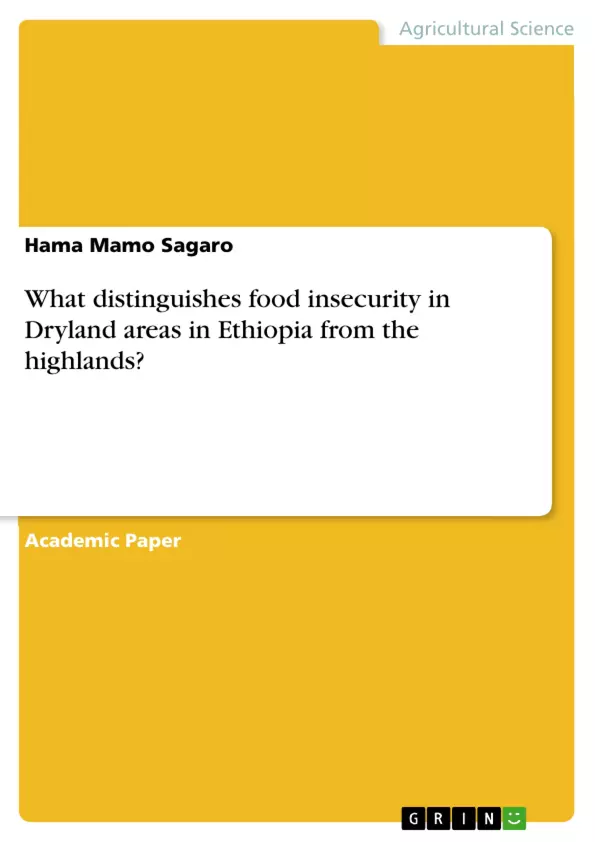Food security and insecurity are terms used to describe whether or not households have access to sufficient quality and quantity of food. Food insecurity is a condition in which people lack the basic food intake necessary to provide them with the energy and nutrients required for fully productive lives. It can either be temporary (transitory food insecurity) or continuous (chronic food insecurity).
Like many developing countries, Ethiopian farmers in the highlands predominantly practice subsistence farming and are often subject to food insecurity. The main objective of the seminar is to review the status of household food insecurity in Ethiopia with a special focus on dryland areas. A review of the status of household food insecurity is vital because it provides information that will enable effective measures to be undertaken to prove food security status and bring the success of food security development programs.
The result of the empirical review indicated, especially in dryland areas of Ethiopia, the majority of households were food insecure. Drought risks, desert locus, the spread of corona varies, protracted impacts of past poor seasons, conflict, poor household income, cost of nutritious food, and knowledge of nutritious food factors are the major drivers of food insecurity.
International non-governmental organizations, local organizations, the private sector, and the government should continue to work together to adopt drought-risk-friendly modern technologies and design new production-oriented and commercialization policies to improve food security.
The data for this review was used from secondary data sources by conducting an intensive reading of published and unpublished journals, articles, and books. Also, this paper is going to review the Causes, indicators, coping mechanisms, and Policy options to minimize household food insecurity in dryland areas of Ethiopia.
Table of Contents
- 1. INTRODUCTION
- 1.1 Background of the seminar
- 1.2 Statement of the problem
- 1.3 Objectives of the seminar
- 1.4 Research questions
- 1.5 Significance of the seminar
- 1.6 Scope and limitation of the study
- 2. LITERATURE REVIEW
- 2.1 Concept of food security
- 2.2 Dimensions of food security
- 2.3 Causes of food insecurity
- 2.4 Food security situation in Ethiopia
- 2.5 Factors affecting household food insecurity
- 3. RESEARCH METHODOLOGY
- 3.1 Study area
- 3.2 Data collection and analysis techniques
- 4. RESULT AND DISCUSSION
- 4.1 Status of food security in dryland areas
- 4.2 Factors contributing to food insecurity in dryland areas
- 4.3 Coping mechanisms adopted by households
- 4.4 Policy options to address food insecurity
- 5. CONCLUSION AND RECOMMENDATION
Objectives and Key Themes
This seminar examines the causes, indicators, and potential solutions to food insecurity in dryland areas of Ethiopia. It aims to understand the specific challenges faced by households in these regions compared to the highlands. The paper utilizes empirical data from published and unpublished sources to provide a comprehensive analysis of the issue.
- Understanding the unique factors contributing to food insecurity in dryland areas.
- Analyzing the coping mechanisms employed by households to mitigate food insecurity.
- Evaluating the effectiveness of existing policies and proposing policy options to improve food security in dryland regions.
- Exploring the role of drought-risk-friendly technologies and commercialization policies in enhancing food security.
Chapter Summaries
- Chapter 1: Introduction: This chapter sets the context by discussing the global prevalence of food insecurity and the significance of the issue in Ethiopia. It defines key terms, highlights the objectives of the seminar, and outlines the research approach.
- Chapter 2: Literature Review: This chapter provides a comprehensive review of existing literature on food security, its dimensions, causes, and the situation in Ethiopia. It examines factors impacting household food insecurity, drawing upon various studies and reports.
- Chapter 3: Research Methodology: This chapter describes the study area, data collection methods, and analysis techniques employed in the research. It clarifies the approach taken to gather and interpret relevant information.
- Chapter 4: Result and Discussion: This chapter presents the findings of the study, focusing on the status of food security in dryland areas, the factors contributing to insecurity, and the coping mechanisms used by households. It also analyzes existing policies and proposes potential solutions.
Keywords
Food insecurity, dryland areas, Ethiopia, household food insecurity, drought, coping mechanisms, policy options, agricultural technologies, commercialization, food security programs.
- Quote paper
- Hama Mamo Sagaro (Author), 2022, What distinguishes food insecurity in Dryland areas in Ethiopia from the highlands?, Munich, GRIN Verlag, https://www.hausarbeiten.de/document/1315420


